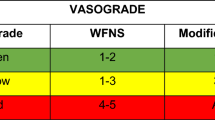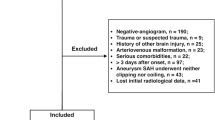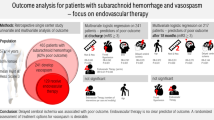Abstract
Background
Vasospasm is a major complication of aneurysmal subarachnoid hemorrhage (SAH) and affects clinical outcome. The ability to predict cerebral vasospasm after SAH would allow the neuro-intensivist to institute preemptive and more aggressive therapy.
Methods
Social, clinical, and radiological information on adult SAH patients recently admitted to our hospital were reviewed. Univariate and multivariate statistical methods were used to examine the impact of patient demographics, clinical variables, and radiologic characteristics on the development of angiographic vasospasm.
Results
One hundred and sixty three patients were identified (102 females, 63%). A total of 34 patients (21%) developed angiographic vasospasm. In univariate analysis, occurrence of cerebral vasospasm was associated with poor World Federation of Neurological Surgeons (WFNS 4–5, P = 0.003) and modified Fisher (MFS 3–4, P = 0.02) grades, elevated Hijdra sum score (HSS ≥23, P = 0.0001), female gender (P = 0.04), development of hydrocephalus (P = 0.01), and a history of tobacco use (P = 0.02). In multivariable analysis, only the HSS ≥23 (P = 0.01) and history of smoking (P = 0.02) predicted cerebral vasospasm. Combined history of smoking and HSS >23 had positive and negative predictive values of 37 and 88%, respectively, for prediction of cerebral vasospasm after aneurysmal hemorrhage.
Conclusions
Hijdra sum score and a history of smoking are the strongest predictors of cerebral vasospasm on angiography. HSS is superior to the MFS as a radiologic grading tool to predict occurrence of angiographic vasospasm after aneurysmal subarachnoid hemorrhage.
Similar content being viewed by others
References
Harrod CG, Bendok BR, Batjer HH. Prediction of cerebral vasospasm in patients presenting with aneurysmal subarachnoid hemorrhage: a review. Neurosurgery. 2005;56:633–54 (discussion 633–654).
Bonilha L, Marques EL, Carelli EF, et al. Risk factors and outcome in 100 patients with aneurysmal subarachnoid hemorrhage. Arq Neuropsiquiatr. 2001;59:676–80.
Chyatte D, Sundt TM Jr. Cerebral vasospasm after subarachnoid hemorrhage. Mayo Clin Proc. 1984;59:498–505.
Lasner TM, Weil RJ, Riina HA, et al. Cigarette smoking-induced increase in the risk of symptomatic vasospasm after aneurysmal subarachnoid hemorrhage. J Neurosurg. 1997;87:381–4.
Torbey MT, Hauser TK, Bhardwaj A, et al. Effect of age on cerebral blood flow velocity and incidence of vasospasm after aneurysmal subarachnoid hemorrhage. Stroke. 2001;32:2005–11.
Fisher CM, Kistler JP, Davis JM. Relation of cerebral vasospasm to subarachnoid hemorrhage visualized by computerized tomographic scanning. Neurosurgery. 1980;6:1–9.
Frontera JA, Claassen J, Schmidt JM, et al. Prediction of symptomatic vasospasm after subarachnoid hemorrhage: the modified fisher scale. Neurosurgery. 2006;59:21–7 (discussion 21–27).
Hijdra A, Brouwers PJ, Vermeulen M, van Gijn J. Grading the amount of blood on computed tomograms after subarachnoid hemorrhage. Stroke. 1990;21:1156–61.
Claassen J, Bernardini GL, Kreiter K, et al. Effect of cisternal and ventricular blood on risk of delayed cerebral ischemia after subarachnoid hemorrhage: the Fisher scale revisited. Stroke. 2001;32:2012–20.
Davis JM, Davis KR, Crowell RM. Subarachnoid hemorrhage secondary to ruptured intracranial aneurysm: prognostic significance of cranial CT. AJR Am J Roentgenol. 1980;134:711–5.
Gurusinghe NT, Richardson AE. The value of computerized tomography in aneurysmal subarachnoid hemorrhage. The concept of the CT score. J Neurosurg. 1984;60:763–70.
Kistler JP, Crowell RM, Davis KR, et al. The relation of cerebral vasospasm to the extent and location of subarachnoid blood visualized by CT scan: a prospective study. Neurology. 1983;33:424–36.
Mizukami M, Takemae T, Tazawa T, et al. Value of computed tomography in the prediction of cerebral vasospasm after aneurysm rupture. Neurosurgery. 1980;7:583–6.
Pasqualin A, Rosta L, Da Pian R, et al. Role of computed tomography in the management of vasospasm after subarachnoid hemorrhage. Neurosurgery. 1984;15:344–53.
Reilly C, Amidei C, Tolentino J, et al. Clot volume and clearance rate as independent predictors of vasospasm after aneurysmal subarachnoid hemorrhage. J Neurosurg. 2004;101:255–61.
van Norden AGW, van Dijk GW, van Huizen MD, et al. Interobserver agreement and predictive value for outcome of two rating scales for the amount of extravasated blood after aneurysmal subarachnoid haemorrhage. J Neurol. 2006;253:1217–20.
Weir BK, Kongable GL, Kassell NF, et al. Cigarette smoking as a cause of aneurysmal subarachnoid hemorrhage and risk for vasospasm: a report of the Cooperative Aneurysm Study. J Neurosurg. 1998;89:405–11.
Chiang VL, Claus EB, Awad IA. Toward more rational prediction of outcome in patients with high-grade subarachnoid hemorrhage. Neurosurgery. 2000;46:28–35 (discussion 35–36).
Author information
Authors and Affiliations
Corresponding author
Additional information
All authors contributed equally to the preparation of this manuscript.
Rights and permissions
About this article
Cite this article
Dupont, S.A., Wijdicks, E.F.M., Manno, E.M. et al. Prediction of Angiographic Vasospasm After Aneurysmal Subarachnoid Hemorrhage: Value of the Hijdra Sum Scoring System. Neurocrit Care 11, 172–176 (2009). https://doi.org/10.1007/s12028-009-9247-3
Received:
Accepted:
Published:
Issue Date:
DOI: https://doi.org/10.1007/s12028-009-9247-3




